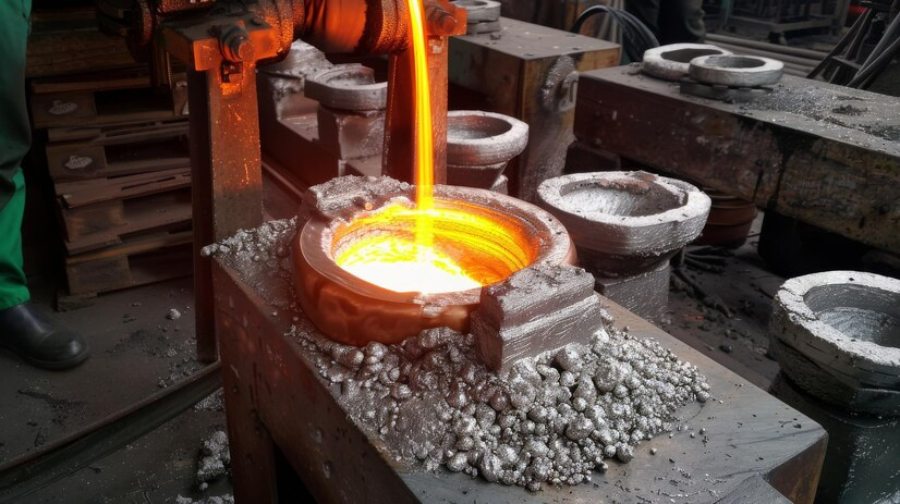Over-molding and die-casting are two manufacturing processes often considered for creating complex components with multiple materials. While they aim to produce intricate parts, they differ significantly in their techniques, materials, applications, and outcomes.
What is Over-Molding?
Overmolding is a manufacturing process that involves injecting one material onto a pre-existing substrate.
This substrate can be made from various materials, including plastic, metal, or even rubber. The over-molded material is typically a polymer, such as thermoplastic or thermoset. Over-molding is a manufacturing process where one material is molded onto an existing component or substrate.
It’s essentially a two-step process that involves:
Creating the substrate: This can be made from various materials like plastic, metal, or rubber.
Injecting the over-mold material: This is typically a polymer, such as thermoplastic or thermoset, which is melted and injected into a mold containing the substrate. The molten material encapsulates the substrate, creating a seamless bond between the two.
Process:
- A base component (substrate) is created using a suitable manufacturing method (injection molding, metal casting, etc.).
- The substrate is placed into a mold cavity.
- The molten polymer is injected into the mold, enveloping the substrate and forming a seamless bond.
- The assembly is cooled, and the finished part is ejected.
Advantages of Over-Molding:
Versatility: Can combine different materials for enhanced properties (e.g., soft-touch grip, electrical conductivity, durability).
Design Flexibility: Creates complex shapes and textures not achievable with single-material processes.
Reduced Assembly: Integrates multiple components into a single piece, streamlining production.
Improved Aesthetics: Offers opportunities for decorative finishes and color combinations.
Disadvantages of Over-Molding:
Higher Cost: Typically more expensive than single-material processes due to tooling and material costs.
Design Constraints: Material compatibility and mold design limitations can restrict part complexity.
Longer Cycle Times: The multi-step process can increase production time compared to single-shot molding.
Die-Casting
Die-casting is a metal casting process where molten metal is injected into a reusable metal mold under high pressure. It produces parts with intricate details and excellent dimensional accuracy. Die casting manufacturers in China follow these processes to prepare the die casting.
Process:
Molten metal (aluminum, zinc, magnesium, copper alloys) is prepared.
The molten metal is injected into a steel mold cavity at high pressure.
The metal rapidly solidifies within the mold, taking the shape of the cavity.
The mold opens, and the finished casting is ejected.
Advantages of Die-Casting:
High Production Rates: Rapid cycle times allow for high-volume production.
Excellent Dimensional Accuracy: Produces parts with tight tolerances and consistent quality.
Strong and Durable: Metal castings offer superior strength and durability compared to plastics.
Thin Wall Capabilities: Creates intricate parts with thin wall sections.
Disadvantages of Die-Casting:
High Tooling Costs: Die-casting molds are expensive to create.
Material Limitations: Primarily used for metals, limiting material choices.
Post-Processing: Castings often require additional finishing (machining, polishing) to achieve the desired surface quality.
Environmental Concerns: Metal casting can generate hazardous waste and emissions.
How To Choosing the Right Process?
Selecting the appropriate manufacturing process between over-molding and die-casting is crucial for achieving optimal product performance, cost-effectiveness, and production efficiency. To make an informed decision, carefully consider the following factors:
The choice between over-molding and die-casting depends on various factors, including:
- Part Design: Complexity, material requirements, and desired properties.
- Production Volume: Required quantity of parts.
- Cost Considerations: Tooling, material, and labor costs.
- Material Properties: Mechanical, thermal, or electrical properties are required.
- Surface Finish: The desired appearance of the final product.
By carefully evaluating these factors, manufacturers can select the most suitable process to achieve their desired outcomes. In some cases, a combination of over-molding and die-casting may be employed to create hybrid components with enhanced performance and functionality.
In Conclusion:
Over-molding and die-casting are both robust manufacturing processes, each with its strengths and limitations. The optimal choice between the two hinges on a careful evaluation of factors such as part design, material requirements, production volume, cost, and desired properties.
Over-molding excels in creating complex parts with multiple materials, offering design flexibility and aesthetic appeal. It is ideal for applications requiring soft-touch finishes, electrical conductivity, or the integration of multiple components. However, it typically involves higher costs and longer cycle times.
Have a Look:-
- 7 Lovable Pug Mixes (With Images) – All Information In 2024
- The Beauty And Personality Of Mix Siamese Cats: A Purrfect Combination
- Everything You Need To Know About The Netherland Dwarf Rabbit: Tiny Titans with Big Personalities

